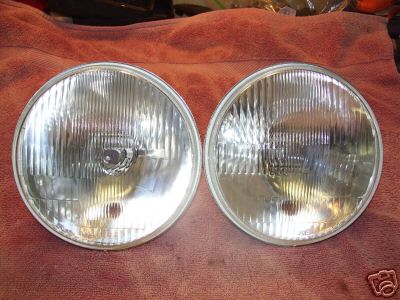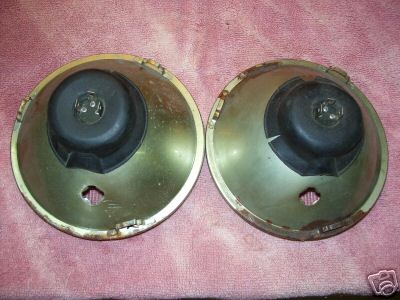Automotive lighting is my professional field. I do research and writing; regulatory, technical, and product development consulting, sales, and I serve as an answer man on the subject for various groups and associations. I am not going to make a pitch for anyone to buy anything from me here; I firmly believe that the most important thing is to get proper, technically sound, factually correct information out there. Then people can make an educated decision to buy headlights from me or anyone else who sells good lights, or they can choose to disregard the facts and go buy bad ones from any of the many vendors who sell them.
"HID kits" in halogen-bulb headlamps (any kit, any headlamp, any vehicle -- including the ones from the many vendors who package it all up as a one-stop-shopping deal where you get your Chinese H4 headlights and your "HID kit" all in one box) do not work safely or effectively, which is why they are illegal. See
this page.
It's not true that any one kind of headlight (H4, HID, sealed beam, etc.) is necessarily better than any other kind of headlight...good headlights are good, and bad headlights are bad. Sylvania's heavily-advertised Silver Star line is junk, and none of the rest of their stuff is worth buying, either. Same goes for Wagner. Cheap H4s are junk, too. You don't have to spend a whack of cash to have good headlights, but bad headlights come at all price levels.
If you are after good, cheap headlights, that's easy. Get
GE Night Hawk H6024NH. Sixteen bucks apiece from Amazon. They are the only sealed beams worth buying, and are substantially better than any sealed beams that have come before. They have all-new lens and reflector optics made on new tooling (all other sealed beams on the market are such junk in part because of outdated design, and in part because they're made on worn-out tooling, having remained unchanged for years).
If you are after good replaceable-bulb headlights, shop carefully. There's a lot of off-brand junk on the market, there are a lot of wrong-side-of-road headlights being brought in to appeal to the kids who drive Hondas and think anything meant for the Japanese market is obviously better, and even if you stick to the reputable brands worth buying (Hella, Bosch, Cibie), there is a large range of performance among them; they're not all the same and neither are they priced alike.
The same goes for bulbs; stick to Osram, Philips, or Narva, and always only ever buy bulbs with colorless clear glass. The blue glass "extra white" bulbs are a scam, a nonstarter as far as seeing better is concerned. Sylvania Silverstar/Ultra, PIAA, Hoen, BlueVision, CrystalVision, TruView, Nokya, Polarg, etc. -- all the same racket. They produce
less light than ordinary bulbs and have a very short life due to the light blocked by the blue glass. All it does is change the beam color, which doesn't help anything (except arbitrary appearance fashion/style).
Xenon and halogen headlamps are two completely different technologies.
They look different because they're supposed to look different. Trying to
match the color of a Xenon headlamp with a halogen bulb is pointless and
counterproductive. It'll never look the way you want it to, and in the
meantime all you're doing is wasting money, reducing your seeing ability,
and creating glare. The "whiter light" and "high kelvin" verbiage that's being
used to sell lighting is bogus. There is no light that is "whiter" than that from a properly-powered halogen bulb with colorless clear glass. All of the so-called "extra white" bulbs use blue or purple glass to tint the light. This does not make the light "whiter", but it does make it significantly less
intense; the colored glass steals a great deal of light that would otherwise reach the road (this is obvious if you think about it; colored filters can only block light, they cannot increase it). There is no seeing advantage to so-called "whiter" light from bulbs with colored glass; in fact such bulbs put you at a distinct seeing disadvantage because of the reduced intensity. In
addition, these bulbs have a very short lifespan because the filament must
be driven very hard to get minimally legal levels of light through the
light-stealing colored glass.
If you are trying to see better, what you need is _more_ light, which will
look whiter *because* there's more light (not because it's tinted to try
to fool you into thinking there's more). For reference, here's manufacturer data*for output and lifespan at 13.2v for standard-wattage H1 bulbs.*The numbers here are a composite of values applicable to the products of*the big three makers (Osram-Sylvania, Philips-Narva, Tungsram-GE). Each*manufacturer's product in each category is slightly different but not*significantly so. *I picked H1-type bulbs for this comparison, and while*the absolute numbers differ with different bulb types, the relative*comparison patterns hold good for whatever bulb type we consider (H4, 9006, whatever).*Lifespan is given as Tc, the hour figure at which 63.2 percent of the*bulbs have failed.
H1 (regular normal):
1550 lumens, 650 hours
Long Life (or "HalogenPlus+")
1460 lumens, 1200 hours
Ultra Long Life (or "DayLight")
1430 lumens, 3000 hours
Plus-30 High Efficacy (CPI BrightLight, Osram Super, Sylvania Xtravision, Narva Rangepower,*Tungsram High Output, Philips Premium):
1700 lumens, 350 hours
Plus-50 Ultra High Efficacy (CPI Super Bright Light, Philips VisionPlus, Osram Silverstar, Narva*Rangepower+50, Tungsram Megalicht, but not Sylvania Silverstar):*
1750 lumens, 350 hours
Plus-80/90 Mega High Efficacy (Philips Xtreme Power, Osram Night Breaker):
1780 lumens, 340 hours
Blue coated 'extra white' (CPI Bright Light Blue, Osram CoolBlue, Narva Rangepower Blue, Philips*BlueVision or CrystalVision, Tungsram Super Blue or EuroBlue, Sylvania*Silverstar or Silverstar Ultra,*also PIAA, Hoen, Nokya, Polarg, etc):
1380 lumens, 250 hours
So that's the pattern for how lifespan and light output are related. It's worth noting that the lumen differences are not the extent of the performance differences. The filament changes required to make a long-life bulb tend to reduce the beam focus, which shortens seeing distance. And, the light color is less white and more brown. But lifespan is lengthened. The opposite filament changes are made to create the "Plus" (+30, +50, +80, +90) type bulbs: Lifespan is reduced, but the beam focus is better so seeing distance is longer. Light color is whiter and less brown. The takeaway message here is that even if all the filaments put out exactly the same amount of light the same lumens from a long life, a +30, a +50, a +90, a regular, an ultralong-life, etc. the headlamp performance and appearance with the long-life bulb would still be inferior compared to the same headlamp performance and appearance with a regular, or +30, or +50, or +80/+90 bulb.
Whatever filament-type headlights you install (sealed beams or H4 units), put in headlight relays and decent-gauge wire to bring full power to the lamps and take the workload off the in-car switches. None of the original wiring has to be cut, removed, or otherwise molested, and the switches keep working normally. Do it
like this. Bulb output is not linear with voltage input, it's exponential to the power 3.4, so small voltage drops mean large losses in light output (and a dingy brown light color...this is what those blue-glass "whiter" bulbs are trying to cover up. :roll

. An additional advantage of this mod is that it keeps all the headlamp current on the engine side of the firewall, reducing the load on your ammeter.
If you are after HID headlights and nothing else will do, then don't futz around with an "HID kit" installed in a halogen light housing. Get a
real HID headlamp. Prepare to open your wallet
wide, and if you get the better-performing one (the XE7 rather than the XE7r), prepare for the front of your car to look like it needs a bra.
There's a new 7" round all-LED headlight available from Truck-Lite. It's DOT-legal, but its performance is pretty minimal. It's a few years yet before we can expect really great LED headlights. But they're certainly cool! Discussion
here.
Aside from headlamps, info on how to make the rest of your car's lights work better is
here.
(I'm not sure how long this post will be allowed to remain up. We'll just have to see.)



















